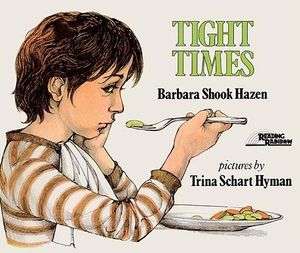Talk About Class: Using Children's Books to Spark ConversationsI developed this list of selected, recommended titles (In a later post, I'll suggest a few titles for older readers):
Socioeconomic class in the U.S. can be even harder to talk about than race, and the silences leave children absorbing unchallenged messages from the dominant culture. Depictions of economic realities in children's books offer the opportunity to engage children in discussion, to find out what they are thinking and to give them permission and language to voice their ideas and impressions.
"Talk About Class"
A Selected, Annotated List of Recommended Picture Books
compiled by Anne Sibley O’Brien
"Children’s literature, an artifact of cultural, social and economic values, provides a window into the ways in which children are socialized to think about social class. And, yet, there is often a silenced dialogue around matters of social class and poverty in society and schools."
Rebecca Rogers,
"Using Children’s Literature to Explore Social Class and Poverty in Times of Economic Crisis" Angel City by Tony Johnston; illustrated by Carole Byard
An older African-American man finds an abandoned Mexican baby in a dumpster in a Los Angeles barrio and determines to raise the child as his own.
Excerpt: “Old man Joseph’s handy. Sees to most needs in his apartment building. Like plumbing. While the old man fits pipes and snakes out drains, Juan swashes toilets with a long-armed brush, for fun.”
A Chair for My Mother written and illustrated by Vera B. Williams
A young girl, her grandmother, and her mother, who works as a waitress, save money for a comfortable chair in their new apartment after a fire destroys their home.
Excerpt: “That was last year, but we still have no sofa and no big chairs. When Mama comes home, her feet hurt. ‘There’s no good place for me to take a load off my feet,’ she says.
Fly Away Home by Eve Bunting; illustrated by Ronald Himler
A homeless white father and son live in an airport. (Also features their friends, the Medinas, a homeless Latino family who care for the boy while the father works.)
Excerpt: “‘Will we ever have our own apartment again?’I ask Dad. I’d like it to be the way it was, before Mom died.
‘Maybe we will,’ he says. ‘If I can find more work. If we can save some money.’”
Sam and the Lucky Money by Karen Chinn; illustrated by Cornelius Van Wright & Ying-Hwan Hu
A Chinese American boy receives money from his grandparents for New Year’s and decides to give it to a homeless Chinese man, instead of spending it on himself.
Excerpt: “The stranger was rubbing his foot. Bare feet in winter! Sam thought. Where are his shoes? Sam stared at the man’s dirty clothes as he backed away.”
Something Beautiful by Sharon Dennis Wyeth; illustrated by Chris K. Soentpiet
An African-American girl living in the inner city is distressed by the lack of beauty in her neighborhood until she goes looking for “something beautiful.”
Excerpt: “I pick up the trash. I sweep up the glass. I scrub the door very hard. When Die disappears, I feel very powerful.
Someday I’ll plant flowers in my courtyard. I’ll invite all my friends to see.”
Tight Times by Barbara Shook Hazen; illustrated by Trina Schart Hyman
A young white boy living in a city apartment begs his parents for a dog, but they refuse because of “tight times.”
Excerpt: “Then Daddy fixed us both special drinks. He said he wasn’t mad at me. He said he was mad because he’d lost something.
I said look behind the radiator because that’s where I found my lost puzzle piece.
Daddy said it wasn’t that simple. What he’d lost was his job.”
Those Shoes by Maribeth Boelts; illustrated by Noah Z. Jones
An African American boy wants a pair of the trendy black high-tops that almost all his classmates are wearing.
Excerpt: “‘There’s no room for ‘want’ around here - just ‘need,’’ Grandma says. ‘And what you need are new boots for winter.”
____
Here's what I found missing from my research into picture book depictions of socioeconomic conditions: rural settings; any content about financial situations or social class in middle- or upper-income settings (economic conditions are only referenced when conditions are stressful).
Next post: Key Points for talking about class & race with children, thoughts about language and stereotypes, and a list of resources.
Please join in with any titles or ideas about this conversation.







2 comments:
Annie,
Thank you for continuing to expand my thinking. I'm going to mull this idea over to see if I can think of other useful examples.
Great, Michelle. This experience is expanding my thinking, too.
Really any book can be an opportunity to talk about social class and economic situations; it's just that we rarely do that.
Post a Comment